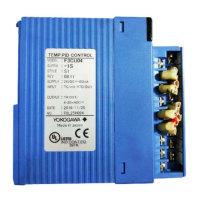What to do if YOKOGAWA F3CU04-0S Control Unit is out of control?
- MMatthew LopezAug 4, 2025
If your YOKOGAWA Control Unit is out of control, and switching it off and on does not restore normal operation, the module should be repaired.

What to do if YOKOGAWA F3CU04-0S Control Unit is out of control?
If your YOKOGAWA Control Unit is out of control, and switching it off and on does not restore normal operation, the module should be repaired.
What to do if there is PV burnout in loop in YOKOGAWA F3CU04-0S Control Unit?
If there is PV burnout in the loop of your YOKOGAWA Control Unit, check the sensor and sensor circuit.
How to fix AD converter error on YOKOGAWA F3CU04-0S Control Unit?
An AD converter error on your YOKOGAWA Control Unit may be due to incorrect wiring. Check the input type setting.
What to do if PV is over in loop of YOKOGAWA F3CU04-0S Control Unit?
If the PV is over in the loop of your YOKOGAWA Control Unit, check the process.
What happens if there is an EEPROM error in YOKOGAWA Control Unit?
If there is an EEPROM error in your YOKOGAWA Control Unit, normal operation continues, but parameter backup to EEPROM is not performed.
| Model | F3CU04-0S |
|---|---|
| Manufacturer | YOKOGAWA |
| Category | Control Unit |
| Series | FA-M3 |
| Operating Temperature | 0 to 55°C |
| Humidity Range | 5 to 95% RH (non-condensing) |
| Power Supply | 24V DC |
| I/O Points | 256 points |
| Communication Protocol | RS-232C |
| Communication Ports | Ethernet |
| Program Language | SFC |
| Weight | 150 g |
| Storage Temperature | -20 to 70°C |
| Vibration Resistance | 10 to 57 Hz, amplitude 0.075 mm |
| Shock Resistance | 147 m/s² |
Overview of the Temperature Control and PID Module.
Guidelines for safe installation, handling, and maintenance of the product.
Detailed technical specifications of the Temperature Control and PID Module.
Step-by-step guide for installing and initially setting up the module.
Procedures for setting hardware switches and performing wiring connections.
Procedure for enabling controller and I/O parameters for effective settings.
Workflow for configuring controller functions from setup to final operation.
Parameters for module-wide setup, including power frequency and controller mode.
Parameters for configuring input and output types and ranges for individual loops.
Parameters defining module operation, including PID settings and auto-tuning.
Describes procedures for operating the module after setup.
Selection of PID, ON/OFF, or heating/cooling control types for controllers.
Selection of analog or open collector output type for each terminal.
Operation details for PID control, including time-proportional and continuous output.
Functions for setting up and controlling inputs and PV processing.
Selecting input types for individual loops using software or hardware switches.
Defining the actual monitoring range by specifying upper and lower input limits.
Selection and manipulation of set points used in control functions.
Selection and storage of pre-defined or remote set points as control set points.
Automatic measurement and calculation of optimal PID constants.
Module automatically determines optimal PID values based on process movement.
Calculates and sets optimal PID constants when instructed by parameters.
Settings for control and computation functions, including PID parameters.
Controls module operation modes like Run/Stop and Automatic/Manual.
Stops PID computation and outputs preset values when set to 'Stop'.
Allows manual control of output values via MOUT/MOUTC parameters.
Configuration and operation of alarms for each loop.
Lists and describes available alarm types with and without waiting.
Suspends automatic parameter storing to EEPROM to protect it.
Identifies and rectifies problems occurring at power up or during operation.
Instructions for diagnosing and resolving common operational errors.
